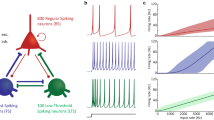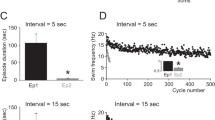Abstract
Rhythmicity is a characteristic of neural networks responsible for locomotion. In many organisms, activation of N-methyl-d-aspartate (NMDA) receptors leads to generation of rhythmic locomotor patterns. In addition, single neurons can display intrinsic, NMDA-dependent membrane potential oscillations when pharmacologically isolated from each other by tetrodotoxin (TTX) application. Such NMDA–TTX oscillations have been characterized, for instance, in lamprey locomotor network neurons. Conceptual and computational models have been put forward to explain the appearance and characteristics of these oscillations. Here, we seek to refine the understanding of NMDA–TTX oscillations by combining new experimental evidence with computational modelling. We find that, in contrast to previous computational predictions, the oscillation frequency tends to increase when the NMDA concentration is increased. We develop a new, minimal computational model which can incorporate this new information. This model is further constrained by another new piece of experimental evidence: that regular-looking NMDA–TTX oscillations can be obtained even after voltage-dependent potassium and high-voltage-activated calcium channels have been pharmacologically blocked. Our model conforms to several experimentally derived criteria that we have set up and is robust to parameter changes, as evaluated through sensitivity analysis. We use the model to re-analyze an old NMDA–TTX oscillation model, and suggest an explanation of why it failed to reproduce the new experimental data that we present here.







Similar content being viewed by others
Abbreviations
- NMDA:
-
N-methyl-d-aspartate
- TTX:
-
tetrodotoxin
- TEA:
-
tetraethylammonium
- AMPA:
-
alpha-amino-3-hydroxy-5-methyl-4- isoxazolepropionic acid
- CPG:
-
central pattern generator
- KCa :
-
calcium-dependent potassium channel
- Kv :
-
voltage-dependent potassium channel
- Cav :
-
voltage-dependent calcium channel
References
Ascher, P., & Nowak, L. (1988). The role of divalent cations in the N-methyl-d-aspartate responses of mouse central neurones in culture. Journal of Physiology London, 399, 247–266.
Brodin, L., Tråvén, H. G., Lansner, A., Wallén, P., Ekeberg, Ö., & Grillner, S. (1991). Computer simulations of N-methyl-d-aspartate receptor-induced membrane properties in a neuron model. Journal of Neurophysiology, 66, 473–484.
Brodin, L., Grillner, S., & Rovainen, C. M. (1985). N-methyl-d-aspartate (NMDA), kainate and quisqualate receptors and the generation of fictive locomotion in the lamprey spinal cord. Brain Research, 325, 302–306.
Büschges, A., Wikström, M. A., Grillner, S., & El Manira, A. (2000). Roles of high-voltage activated calcium channel subtypes in a vertebrate spinal locomotor network. Journal of Neurophysiology, 85, 2758–2766.
El Manira, A., & Bussières, N. (1997). Calcium channel subtypes in lamprey sensory and motor neurons. Journal of Neurophysiology, 78, 1334–1340.
El Manira, A., Tegnér, J., & Grillner, S. (1994). Calcium-dependent potassium channels play a critical role for burst termination in the locomotor network in lamprey. Journal of Neurophysiology, 72, 1852–1861.
Ermentrout, B. (2002). Simulating, analyzing and animating dynamical systems: A guide to XPPAUT for researchers and students. Philadelphia: SIAM.
Grillner, S., & Wallén, P. (1985). The ionic mechanisms underlying N-methyl-d-aspartate receptor-induced, tetrodotoxin-resistant membrane potential oscillations in lamprey neurons active during locomotion. Neuroscience Letters, 60, 289–294.
Guertin, P. A., & Hounsgaard, J. (1998). Chemical and electrical stimulation induce rhythmic motor activity in an in vitro preparation of the spinal cord from adult turtles. Neuroscience Letters, 245, 5–8.
Guertin, P. A., & Hounsgaard, J. (2006). Conditional intrinsic voltage oscillations in mature vertebrate neurons undergo specific changes in culture. Journal of Neurophysiology, 95, 2024–2027.
Heinrich, R., & Rapoport, T. A. (1974). A linear steady-state treatment of enzymatic chains. Critique of the crossover theorem and a general procedure to identify interaction sites with an effector. European Journal of Biochemistry, 42, 97–105.
Hess, D., Nanou, E., & El Manira, A. (2007). Characterization of Na+-activated K+ currents in larval lamprey spinal cord neurons. Journal of Neurophysiology, 97, 3484–3493.
Huss, M., Lansner, A., Wallén, P., El Manira, A., Grillner, S., & Hellgren Kotaleski, J. (2007). Roles of ionic currents in lamprey CPG neurons: A modeling study. Journal of Neurophysiology, 97, 2696–2711.
Kahn, J. A. (1982). Patterns of synaptic inhibition in motoneurons and interneurons during fictive swimming in the lamprey, as revealed by Cl − injections. Journal of Comparative Physiology, 147, 189–194.
Kozlov, A., Hellgren Kotaleski, J., Aurell, E., Grillner, S., & Lansner, A. (2001) Modeling of substace P and 5-HT induced synaptic plasticity in the lamprey spinal CPG: Consequences for network pattern generation. Journal of Computational Neuroscience, 11, 183–200.
Ingalls, B. P. (2004). Autonomously oscillating biochemical systems: Parametric sensitivity of extrema and period. IEE Systems Biology, 1, 62–70.
MacLean, J. N., Schmidt, B. J., Hochman, S. (1997). NMDA receptor activation triggers voltage oscillations, plateau potentials and bursting in neonatal rat lumbar motoneurons in vitro. European Journal of Neuroscience, 9, 2702–2711.
Moore, L., & Buchanan, J. (1993). The effects of neurotransmitters on the integrative properties of spinal neurons in the lamprey. Journal of Experimental Biology, 175, 89–114.
Nowak, L., Bregestovski, P., Ascher, P., Herbet, P., & Prochiantz, A. (1984). Magnesium gates glutamate-activated channels in mouse central neurones. Nature, 307, 462–465.
Russell, D. F., & Wallén, P. (1983). On the control of myotomal motoneurones during “fictive swimming” in the lamprey spinal cord in vitro. Acta Physiologica Scandinavica, 117, 161–170.
Schmidt, H., & Jirstrand, M. (2006). Systems biology toolbox for MATLAB: A computational platform for research in systems biology. Bioinformatics, 22, 514–515.
Schmidt, B. J., Hochman, S., & MacLean, J. N. (1998). NMDA receptor-mediated oscillatory properties: Potential role in rhythm generation in the mammalian spinal cord. Annals of the New York Academy of Sciences, 860, 189–202.
Sillar, K. T., & Simmers, A. J. (1994). 5-HT induces NMDA receptor-mediated intrinsic oscillations in embryonic amphibian spinal neurons. Proceedings of the Royal Society of London Series B Biological Sciences, 255, 139–145.
Tegnér, J., & Grillner S. (1999). Interactive effects of the GABABergic modulation of calcium channels and calcium-dependent potassium channels in lamprey. Journal of Neurophysiology, 81, 1318–1329.
Tegnér, J., Lansner, A., & Grillner, S. (1998). Modulation of burst frequency by calcium-dependent potassium channels in the lamprey locomotor system: Dependence of the activity level. Journal of Computational Neuroscience, 5, 121–140.
Wallén, P., & Grillner, S. (1987). N-methyl-D-aspartate receptorinduced, inherent oscillatory activity in neurons active during fictive locomotion in the lamprey. Journal of Neuroscience, 7, 2745–2755.
Wallén, P., & Williams, T. (1984). Fictive locomotion in the lamprey spinal cord in vitro compared with swimming in the intact and spinal animal. Journal of Physiology, 347, 225–239.
Wikström, M. A., & El Manira, A. (1998). Calcium influx through N- and P/Q-type channels activate apamin-sensitive calcium-dependent potassium channels generating the late afterhyperpolarization in lamprey spinal neurons. European Journal of Neuroscience, 10, 1528–1532.
Acknowledgements
MH was supported by European Commission grant IST-001917 (“Neurobotics”). JHK acknowledges support from the Swedish Research Council. We thank Ebba Samuelsson, Russell Hill, Peter Wallén, Elling Jacobsen, Sten Grillner, Anders Lansner and Pål Westermark for useful discussions.
Author information
Authors and Affiliations
Corresponding author
Additional information
Action Editor: Christiane Linster
Rights and permissions
About this article
Cite this article
Huss, M., Wang, D., Trané, C. et al. An experimentally constrained computational model of NMDA oscillations in lamprey CPG neurons. J Comput Neurosci 25, 108–121 (2008). https://doi.org/10.1007/s10827-007-0067-1
Received:
Revised:
Accepted:
Published:
Issue Date:
DOI: https://doi.org/10.1007/s10827-007-0067-1




